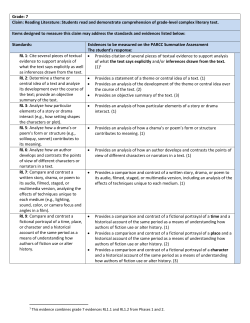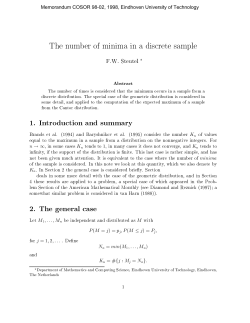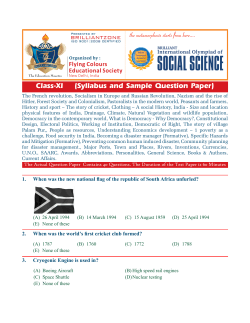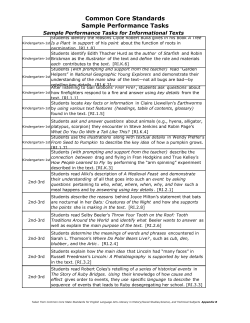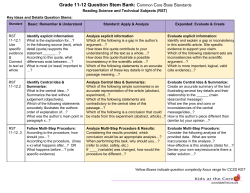
PARCC Grade 8 Reading Evidence Tables
Grade: 8 Claim: Reading Literature: Students read and demonstrate comprehension of grade-level complex literary text. Items designed to measure this claim may address the standards and evidences listed below: Standards: Evidences to be measured on the PARCC Summative Assessment RL 1: Cite the textual evidence that most strongly supports an analysis of what the text says explicitly as well as inferences drawn from the text. RL 2: Determine a theme or central idea of a text and analyze its development over the course of the text, including its relationship to the characters, setting, and plot; provide an objective summary of the text. RL 3: Analyze how particular lines of dialogue or incidents in a story or drama propel the action, reveal aspects of a character, or provoke a decision. The student’s response: Provides textual evidence that most strongly supports analysis of what the text says explicitly and/or inferences drawn from the text. (1)1 RL 5: Compare and contrast the structure of two or more texts and analyze how the differing structure of each text contributes to its meaning and style. RL 6: Analyze how differences in the points of view of the characters and the audience or reader (e.g., created through the use of dramatic irony) create such effects as suspense or humor. RL 7: Analyze the extent to which a filmed or live production of a story or drama stays faithful to or departs from the text or script, evaluating the choices made by the director or actors. RL 9: Analyze how a modern work of fiction draws on themes, patterns of events, or character types from myths, traditional stories, or religious works such as the Bible, including describing how the material is rendered new. 1 Provides a statement of a theme or central idea of a text, based on textual evidence. (1) Provides an analysis of the development of the theme or central idea over the course of the text. (2) Provides an analysis of how the theme or central idea relates to the characters, setting, and/or plot. (3) Provides an objective summary of a text. (4) Provides an analysis of how particular lines of dialogue or incidents in a story or drama propel the action. (1) Provides an analysis of how particular lines of dialogue or incidents in a story or drama provoke a decision. (2) Provides an analysis of how particular lines of dialogue or incidents in a story or drama reveal aspects of a character. (3) Provides a comparison and contrast of the structure of two or more texts. (1) Provides an analysis of how the differing structure of each text contributes to its meaning and style. (2) Provides an analysis of how one or more differences in the points of view of the characters and the audience and/or reader (e.g. through the use of dramatic irony) create such effects as suspense or humor. (1) Provides an analysis of the extent to which a filmed production of a story or drama stays faithful to or departs from the text or script, including an evaluation of the choices made by the director or actors. (1) Provides an analysis of how a modern work of fiction draws on themes, patterns of events, and/or character types, including describing how the material is rendered new. (1) This evidence combines grade 8 evidences RL1.1 and RL1.2 from Phases 1 and 2. Grade: 8 Claim: Reading Information: Students read and demonstrate comprehension of grade-level complex informational texts. Items designed to measure this claim may address the standards and evidences listed below: Standards: Evidences to be measured on the PARCC Summative Assessment The student’s response: RI 1: Cite the textual evidence that most strongly For RI 1, provides textual evidence that most strongly supports supports an analysis of what the text says explicitly analysis of what the text says explicitly and/or inferences drawn as well as inferences drawn from the text. from the text. (1)2 RST 1: Cite specific textual evidence to support analysis of science and technical texts. For RST and RH, provides textual evidence to support an analysis of RH 1: Cite specific textual evidence to support science and/or technical texts or to support analysis of primary analysis of primary and secondary sources. and/or secondary sources. (3) RI 2: Determine a central idea of a text and analyze Provides a statement of a central idea of a text. (1) its development over the course of the text, Provides an analysis of the development of a central idea over the including its relationship to supporting ideas; course of the text, including its relationship to supporting ideas. (2) provide an objective summary of the text. Provides an objective summary of a text. (3) RST 2: Determine the central ideas or conclusions For RST 2, determines the central ideas or conclusions of a text. (4) of a text; provide an accurate summary of the text For RH 2, determines the central ideas or information of a primary or distinct from prior knowledge or opinions. secondary source. (5) RH 2: Determine the central ideas or information of a primary or secondary source; provide an accurate summary of the source distinct from prior knowledge or opinions. RI 3: Analyze how a text makes connections among For RI 3, provides an analysis of how a text makes connections and distinctions between individuals, ideas, or among and distinctions between individuals (e.g., through events (e.g., through comparisons, analogies, or comparisons, analogies, or categories). (1) categories). For RI 3, provides an analysis of how a text makes connections RST 3: Follow precisely a multistep procedure when among and distinctions between ideas (e.g., through comparisons, carrying out experiments, taking measurements, or analogies, or categories). (2) performing technical tasks. For RI 3, provides an analysis of how a text makes connections RH 3: Identify key steps in a text’s description of a among and distinctions between events (e.g., through comparisons, process related to history/social studies (e.g., how analogies, or categories). (3) a bill becomes law, how interest rates are raised or For RST 3, demonstrates ability to follow a multistep procedure lowered). when carrying out experiments, taking measurements, or performing technical tasks. (4) For RH 3, provides an identification of key steps in a text’s description of a process related to history/social studies. (5) RI 5: Analyze in detail the structure of a specific For RI 5, provides a detailed analysis of the structure of a specific paragraph in a text, including the role of particular paragraph in a text, including the role of particular sentences in sentences in developing and refining a key concept. developing and refining a key concept. (1) RST 5: Analyze the structure an author uses to For RST 5, provides an analysis of the structure an author uses to organize a text, including how the major sections organize a text, including how the major sections contribute to the contribute to the whole and to an understanding of whole and to an understanding of the topic. (2) the topic. For RH 5, provides a description of how a text presents information RH 5: Describe how a text presents information (e.g., sequentially, comparatively, causally). (3) (e.g., sequentially, comparatively, causally). RI 6: Determine an author’s point of view or purpose in a text and analyze how the author acknowledges and responds to conflicting evidence or viewpoints. RST 6: Analyze the author’s purpose in providing an explanation, describing a procedure, or discussing an experiment in text .RH 6: Identify aspects of a text that reveal an author’s point of view or purpose (e.g., loaded language, inclusion or avoidance of particular facts). For RI 6, provides a statement of an author’s point of view in a text. (1) For RI 6, provides a statement of an author’s purpose in a text. (2) For RI 6, provides an analysis of how the author acknowledges and responds to conflicting evidence and/or viewpoints. (3) For RST 6, provides an analysis of the author’s purpose in providing an explanation, describing a procedure, or discussing an experiment in a text. (4) For RH 6, provides an identification of aspects of a text that reveal an author’s point of view (e.g. loaded language, inclusion or avoidance of particular facts). (5) For RH 6, provides an identification of aspects of a text that reveal an author’s purpose (e.g. loaded language, inclusion or avoidance of particular facts). (6) RI 7: Evaluate the advantages and disadvantages of using different mediums (e.g., print or digital text, video, multimedia) to present a particular topic or idea. RST 7: Integrate quantitative or technical information expressed in words in a text with a version of that information expressed visually (e.g., in a flowchart, diagram, model, graph, or table). RH 7: Integrate visual information (e.g., in charts, graphs, photographs, videos, or maps) with other information in print and digital texts. RI 8: Delineate and evaluate the argument and specific claims in a text, assessing whether the reasoning is sound and the evidence is relevant and sufficient; recognize when irrelevant evidence is introduced. RST 8: Distinguish among facts, reasoned judgment based on research findings, and speculation in a text. RH 8: Distinguish among fact, opinion, and reasoned judgment in a text. RI 9: Analyze a case in which two or more texts provide conflicting information on the same topic and identify where the texts disagree on matters of fact or interpretation. RST 9: Compare and contrast the information gained from experiments, simulations, video, or multimedia sources with that gained from reading a text on the same topic. RH 9: Analyze the relationship between a primary and secondary source on the same topic. 2 For RI 7, provides an evaluation of the advantages and disadvantages of using different mediums (e.g. print or digital text, video, multimedia) to present a particular topic or idea. (1) For RST 7, provides an integration of quantitative information expressed in words in a text with a version of that information expressed visually (e.g., in a flowchart, diagram, model, graph, or table). (2) For RST 7, provides an integration of technical information expressed in words in a text with a version of that information expressed visually (e.g., in a flowchart, diagram, model, graph, or table). (3) For RH 7, provides integration of visual information (e.g., in charts, graphs, photographs, videos, or maps) with other information in print and digital texts. (4) For RI 8, provides a delineation of the argument and specific claims in a text. (1) For RI 8, provides an assessment of whether the reasoning of the argument is sound. (2) For RI 8, provides an evaluation of whether the evidence is relevant and sufficient to support the claims. (3) For RI 8, demonstrates recognition of when irrelevant evidence is introduced. (4) For RST 8, provides distinctions among facts, reasoned judgment based on research findings, and/or speculation in a text. (5) For RH 8, provides distinctions made among fact, opinion, and/or reasoned judgment in a text. (6) For RI 9, provides an analysis of a case in which two or more texts provide conflicting information on the same topic and identify where the texts disagree on matters of fact or interpretation. (1) For RST 9, provides a comparison and contrast of the information gained from experiments, simulations, video or multimedia sources with that gained from reading a text on the same topic. (2) For RH 9, provides an analysis of the relationship between a primary and secondary source on the same topic. (3) This evidence combines grade 8 evidences RI1.1 and RI1.2 from Phases 1 and 2. Grade: 8 Claim: Vocabulary Interpretation and Use: Students use context to determine the meaning of words and phrases. Items designed to measure this claim may address the standards and evidences listed below: Standards: Evidences to be measured on the PARCC Summative Assessment The student’s response: RL 4: Determine the meaning of words Demonstrates the ability to determine the meaning of words and phrases as and phrases as they are used in a text, they are used in a text (e.g., figurative, connotative) and/ or provides an including figurative and connotative analysis of the impact of specific word choice on meaning and/or tone, meanings; analyze the impact of specific including analogies or allusions to other texts. (1) word choices on meaning and tone, including analogies or allusions to other texts. RI 4: Determine the meaning of words and phrases as they are used in a text, including figurative, connotative, and technical meanings; analyze the impact of specific word choices on meaning and tone, including analogies or allusions to other texts. RH 4: Determine the meaning of words and phrases as they are used in a text, including vocabulary specific to domains related to history/social studies. RST 4: Determine the meaning of symbols, key terms, and other domainspecific words and phrases as they are used in a specific scientific or technical context relevant to grades 6-8 texts and topics. L 4: Determine or clarify the meaning of unknown and multiple-meaning words or phrases based on grade 8 reading and content, choosing flexibly from a range of strategies. a. Use context (e.g., the overall meaning of a sentence or paragraph; a word’s position or function in a sentence) as a clue to the meaning of a word or phrase. b. Use common, grade-appropriate Greek or Latin affixes and roots as clues to the meaning of a word (e.g., precede, recede, secede). c. Consult general and specialized reference materials (e.g., dictionaries, glossaries, thesauruses), both print and digital, to find the pronunciation of a word or determine or clarify its precise meaning or its part of speech. d. Verify the preliminary determination of the meaning of a word or phrase (e.g., by checking the inferred meaning in context or in a dictionary). L 5: Demonstrate understanding of figurative language, word relationships, and nuances in word meanings. a. Interpret figures of speech (e.g. verbal irony, puns) in context. b. Use the relationship between particular words to better understand each of the words. Demonstrates the ability to determine the meaning of words and phrases as they are used in a text (e.g., figurative, connotative, technical) and/or provides an analysis of the impact of specific word choice on meaning and/or tone, including analogies or allusions to other texts. (1) For RST 4, demonstrates the ability to determine the symbols, key terms, and other domain-specific words and phrases that are used in a specific scientific or technical context relevant to grades 6–8 texts and topics. (2) FOR DIAGNOSTIC ONLY: Demonstrates the ability to determine the meaning of vocabulary specific to domains related to history/social studies. (3) FOR DIAGNOSTIC ONLY: Demonstrates the ability to determine the meaning of domain-specific words and phrases as they are used in a specific scientific or technical context relevant to grades 6-8 texts and topics. Demonstrates the ability to use context (e.g., the overall meaning of a sentence or paragraph; a word’s position or function in a sentence) as a clue to the meaning of a word or phrase. (1) FOR DIAGNOSTIC ONLY: Demonstrates the ability to use common, gradeappropriate Greek or Latin affixes and roots as clues to the meaning of a word (e.g., precede, recede, secede). (2) Demonstrates the ability to determine the connotations (associations) of words with similar denotations (definitions) (e.g., bullheaded, willful, firm, persistent, resolute). (1) Demonstrates the ability to interpret figures of speech (e.g., verbal irony, puns) in context. (2) Demonstrates the ability to determine the relationship between particular words. (3) c. Distinguish among the connotations (associations) of words with similar denotations (definitions) (e.g., bullheaded, willful, firm, persistent, resolute). L 6: Acquire and use accurately gradeappropriate general academic and domain-specific words and phrases; gather vocabulary knowledge when considering a word or phrase important to comprehension or expression. Provides a statement demonstrating accurate meaning and use of gradeappropriate general academic words and phrases. (1)
© Copyright 2025
